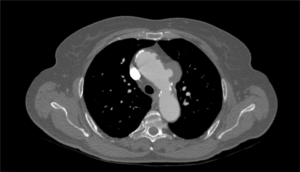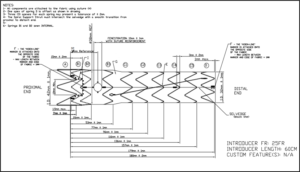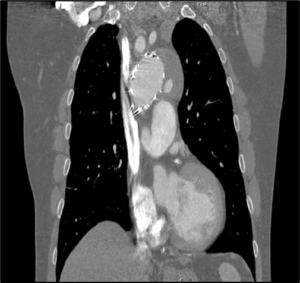Linardi Daniele1*, Gardellini Jacopo1, Di Nicola Venanzio1, Boschetti Vincenzo1, Denora Maria Teresa1, Puntel Gino2, Puppini Giovanni2, Luciani Giovanni Battista1
1Department of Cardiac Surgery, University of Verona, Verona, Italy
2Department of Radiology, University of Verona, Verona, Italy
*Correspondence author: Daniele Linardi, MD, PhD, Department of Cardiac Surgery, University of Verona, Verona, Italy; Email: [email protected]
Published On: 02-07-2024
Copyright© 2024 by Linardi D, et al. All rights reserved. This is an open access article distributed under the terms of the Creative Commons Attribution License, which permits unrestricted use, distribution and reproduction in any medium, provided the original author and source are credited.
Abstract
Penetrating Atherosclerotic Ulcer (PAU) is one of the acute aortic syndromes representing a medical and surgical emergency that could lead to rapid evolution and significant complications. Depending on the aortic section involved in the PAU, the treatment with endovascular prosthesis could be challenging and often requires personalized prosthesis to face anatomical peculiarities. The aortic arch could be one of the most complex locations due to the origin of supra-aortic branches and the need for previous or subsequent carotid-subclavian bypass grafting. The use of scalloped and fenestrated prostheses makes it possible to manage aortic pathology without further vascular surgery.
Keywords: Aortic Arch; Endovascular Therapy; TEVAR; Custom Made Solutions; Penetrating Aortic Ulcer
Technology
Penetrating Atherosclerotic Ulcer (PAU) evolves from an aortic atherosclerotic plaque caused by a crack in the internal elastic lamina that allows blood flow between the intima and media. The clinical history of PAU comprises the development of intramural hematoma, pseudoaneurysm, acute or chronic aortic dissection and even aortic rupture [1]. Asymptomatic PAUs are common in the elderly population and display infrequent evolution; uncomplicated PAUs may be treated with optimal medical management that includes antihypertensives, acetylsalicylic acid and statins. Furthermore, regular CT follow-up and risk factor reduction are fundamental [2]. Patients who exhibit pain appearance should be considered as a medical emergency and could request immediate intervention. Moreover, PAU involving the aortic arch could lead to an aortic dissection involving the descending aorta (Non-A/Non-B or Type B dissection) or a retrograde type A dissection [3].
Although open surgery could resolve the pathology, endovascular repair is the current treatment of choice. This case describes a complete endovascular treatment for complicated aortic arch PAU with a custom-made prosthesis and the most common postoperative complication management. A custom-made prosthesis was designed to suit perfectly the patient’s anatomy, with a scallop to encircle the origin of the left common carotid artery without obstructing the blood flow. Moreover, the prosthesis was cone-shaped to fit the arch dilatation and minimize endoleaks formation risk.
Technique and Case Description
A 73-year-old woman, being in follow-up for an ectasia involving the ascending aorta and aortic arch, came to the A&E of our institution referring chest pain onset in the morning, radiated to the epigastrium and the back. The patient had a clinical history of hypertension, multinodular goiter, COPD, psoriatic arthritis, nephrolithiasis and a previous episode of venous thrombosis. A Computed Tomography (CT) was performed, highlighting a saccular pseudoaneurysm protruding from the aortic arch left profile originating from a PAU, right after the left carotid artery origin, zone 2 of Ishimaru [4]. Despite evidence of initial pseudoaneurysm thrombosis, the presence of continuous flow between the aorta through the PAU and the pain onset led to the suspicion of an acute evolution of the pathology. The patient was hospitalized and observed in ICU with invasive pressure monitoring. Another angio-CT scan was performed after 48 hours, confirming the presence of a pseudoaneurysm derived from a PAU affecting the aortic arch (Fig. 1).

Figure 1: TC image of Penetrating Atherosclerotic Ulcer (PAU).
After 48 hours, the patient was admitted to the cardiac surgery department in order to discuss and program the best treatment for the aortic arch ulcer.
The PAU of the aortic arch could be treated with a surgical approach and an aortic arch replacement or with a hybrid approach involving an extrathoracic carotid-carotid-subclavian bypass and a TEVAR or a total endovascular treatment with a custom-made prosthesis.
The patient’s condition and the risks of the three treatment options, including the risk of waiting for the custom-made prosthesis, were discussed with the patient and her family. The patient decided to avoid thoracic surgery and, worried about future goiter treatment, decided on a total endovascular solution.
No other episodes of chest pain were registered with optimal medical hypertension management during the hospitalization, the patient was dismissed, waiting for the custom-made prosthesis. Our hospital’s multidisciplinary team, composed of cardiac surgeons, radiologists and engineers, managed to project a complete endovascular repair, avoiding the need for carotid-carotid-subclavian grafting. The custom-made prosthesis was characterized by a scallop for the left carotid artery and a fenestration for the left subclavian artery (Fig. 2).

Figure 2: Custom made prosthesis project.
The procedure was performed in the angiographic operation theatre 45 days after the first hospitalization. After surgical right femoral artery exposure and percutaneous left humeral artery cannulation, a customized Bolton Relay Plus, cone-shaped owing to the proximal aortic arch dilatation, an endovascular prosthesis (dimension 42-32 x 180 mm), was inserted during radiographic monitoring. Proximal landing zone nearby left common carotid artery with the scallop placed on the artery’s origin to guarantee complete branch patency. When the correct landing zone was reached, before complete prosthesis placement, a stiff wire was inserted from the left subclavian artery through the planned fenestration to guide the covered vascular stent positioning later. The endovascular prosthesis was deployed and the covered stent was placed through apposite fenestration in the prosthesis. Angiography confirmed the complete exclusion of the pseudoaneurysm and normal patency of the left common carotid artery and the left subclavian artery. The procedure was concluded without any complications and no neurological or cardiac lesions occurred. The patient was extubated within a few hours of the procedure and stayed in the intensive care unit for one night. The postoperative course was regular and the patient was dismissed after five days of hospitalization.
Despite clinical improvements and early CT control that showed good surgery results, a two-month TC follow-up described a type IA endoleak that caused the revascularization of the previously excluded pseudoaneurysm (Fig. 3).

Figure 3: TC after 2 months endoleak IA after TEVAR.
An endovascular ballooning (Abbott Vascular Armada 35 10,0 mm x 40 mm x 80 cm) with transvenous rapid cardiac pacing was performed. At the end of the procedure, angiography confirmed the absence of the previous endoleak; the patient was discharged three days later. Three months of CT control confirmed the endovascular treatment’s excellent results, with complete occlusion of the previous aneurysm and no evidence of periprosthetic leaks (Fig. 4).

Figure 4: Angiographic result after endovascular ballooning.
Clinical Experience
Open and hybrid surgery approaches are no longer the best alternatives in treating aortic arch pathology, such as PAUs and aneurysms. Thoracic endovascular aneurysm repair and endovascular surgery procedures offer a practical alternative to managing many aortic diseases with low morbidity and mortality [5]. Moreover, personally designed prostheses and complete endovascular repair could improve medical treatment, reducing hospital stays and perioperative risks.
It has already been pointed out that open and endovascular surgery procedures exhibit no significant differences in the perioperative and postoperative complications rate, even considering patients of different ages and comorbidities. In our case, the possibility of using a scalloped and fenestrated prosthesis allowed us to avoid complex debranching or bypass surgery and approach aortic arch PAU disease avoiding an elevated surgery risk.
Avoiding debranching and neck dissection could prevent some severe complications connected with epiaortic vessel surgery, such as carotid clamping, risking plaque disruption, cerebral ischemia or nerve injury and should be preferred, especially in selected patients with neck or vascular anatomy peculiarities [7].
The use of a custom-made prosthesis allows better maneuverability during device-delivering procedures. The scallop placed for the common carotid artery allows the extension of the proximal zone closer to the ascending aorta without causing flow reduction or interruption in epiaortic branches. Although custom-made prostheses might represent a perfect solution in any aortic pathology, the time factor should be considered. Tailored device design and consequent endoprosthesis manufacture require approximately one month; the aortic disease could progress or worsen during this waiting period. Disease evolution risk should definitely be considered before evaluating the custom-made solution. However, customized prostheses, including fenestrated and scalloped ones, allow the approach of complex anatomical features, minimizing further complications risk and representing the best way to solve aortic pathology, showing in several studies’ excellent outcomes in selected patients [8]. Despite the evident advantages, we should not consider endovascular procedures riskless because they can certainly be complicated by endoleaks or other clinical problems. The development of endoleaks and complications, even with an intraoperative positive result, should be considered during postoperative follow-up planning.
Conclusion
Complete endovascular treatment of the aortic arch could and should be considered a valid approach to aortic pathologies. However, it often requires a custom-made approach and is not always applicable. Regular follow-up is necessary to monitor any complications and study operative management to fix them.
Conflict of Interests
The authors have no conflict of interest to declare related to this article.
References
- Stanson AW, Kazmier FJ, Hollier LH, Edwards WD, Pairolero PC, Sheedy PF, et al. Penetrating atherosclerotic ulcers of the thoracic aorta: natural history and clinicopathologic correlations. Ann Vasc Surg. 1986;1(1):15-23.
- DeCarlo C, Latz CA, Boitano LT, Kim Y, Tanious A, Schwartz SI, et al. Prognostication of asymptomatic penetrating aortic ulcers: a modern approach. Circulation. 2021;144(14):1091-101.
- Salim S, Machin M, Patterson BO, Bicknell C. The management of penetrating aortic ulcer. Hearts. 2020;1:5-13.
- Ishimaru S. Endografting of the aortic arch. J Endovasc Ther. 2004;11(Suppl 2):62-71.
- Di Marco L, Murana G, Lovato L, Gliozzi G, Buia F, Attinà D, et al. Endovascular solutions for aortic arch diseases: total and hybrid. Surg Technol Int. 2021;38:331-8.
- De Rango P, Ferrer C, Coscarella C, Musumeci F, Verzini F, Pogany G, et al. Contemporary comparison of aortic arch repair by endovascular and open surgical reconstructions. J Vasc Surg. 2015;61(2):339-46.
- Nick Ng ZP, Tay KH, Chong TT. Total percutaneous access for deployment of a custom-made fenestrated stent graft in a 90-year-old with a large symptomatic thoracic aortic aneurysm. EJVES Vasc Forum. 2021;51:30-3.
- Tan GWL, Quek L, Tan BP, Pua U. Early experience and lessons learnt with customized fenestrated thoracic endovascular aortic reconstruction for aortic arch pathology in an asian population. Cardiovasc Intervent Radiol. 2018;41(4):544-53.
Article Type
Case Report
Publication History
Received On: 27-05-2024
Accepted On: 24-06-2024
Published On: 02-07-2024
Copyright© 2024 by Linardi D, et al. All rights reserved. This is an open access article distributed under the terms of the Creative Commons Attribution License, which permits unrestricted use, distribution, and reproduction in any medium, provided the original author and source are credited.
Citation: Linardi D, et al. Avoiding Aortic Arch Debranching with a Custom-Made Solution a Tailored Approach to Aortic Disease. J Surg Res Prac. 2024;5(2):1-5.

Figure 1: TC image of Penetrating Atherosclerotic Ulcer (PAU).

Figure 2: Custom made prosthesis project.

Figure 3: TC after 2 months endoleak IA after TEVAR.

Figure 4: Angiographic result after endovascular ballooning


